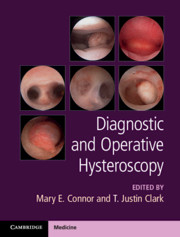Book contents
- Diagnostic and Operative Hysteroscopy
- Diagnostic and Operative Hysteroscopy
- Copyright page
- Dedication
- Contents
- Videos
- Contributors
- Chapter 1 An Introduction to Hysteroscopy
- Chapter 2 Anatomy and Physiology of the Uterus
- Chapter 3 Infrastructure and Instrumentation for Hysteroscopy
- Chapter 4 Diagnostic Hysteroscopy: Accuracy and Interpretation of Findings
- Chapter 5 Hysteroscopy Techniques and Treatment Settings
- Chapter 6 Analgesia and Anaesthesia for Hysteroscopy
- Chapter 7 Indications for Hysteroscopy
- Chapter 8 Hysteroscopic Electrosurgery
- Chapter 9 Complications of Hysteroscopic Surgery
- Chapter 10 Hysteroscopic Endometrial Polypectomy
- Chapter 11 Endometrial Ablation
- Chapter 12 Hysteroscopic Management of Fibroids
- Chapter 13 Hysteroscopic Sterilisation
- Chapter 14 Management of Congenital Uterine and Vaginal Anomalies
- Chapter 15 Hysteroscopic Management of Uterine Adhesions
- Chapter 16 Unusual Hysteroscopic Situations: Caesarean Niche and Retained Placental Tissue
- Chapter 17 Audit, Data Collection and Clinical Governance in Hysteroscopy
- Chapter 18 Training in Hysteroscopic Skills
- Chapter 19 Research and New Developments in Hysteroscopy
- Index
- References
Chapter 1 - An Introduction to Hysteroscopy
Published online by Cambridge University Press: 10 September 2020
- Diagnostic and Operative Hysteroscopy
- Diagnostic and Operative Hysteroscopy
- Copyright page
- Dedication
- Contents
- Videos
- Contributors
- Chapter 1 An Introduction to Hysteroscopy
- Chapter 2 Anatomy and Physiology of the Uterus
- Chapter 3 Infrastructure and Instrumentation for Hysteroscopy
- Chapter 4 Diagnostic Hysteroscopy: Accuracy and Interpretation of Findings
- Chapter 5 Hysteroscopy Techniques and Treatment Settings
- Chapter 6 Analgesia and Anaesthesia for Hysteroscopy
- Chapter 7 Indications for Hysteroscopy
- Chapter 8 Hysteroscopic Electrosurgery
- Chapter 9 Complications of Hysteroscopic Surgery
- Chapter 10 Hysteroscopic Endometrial Polypectomy
- Chapter 11 Endometrial Ablation
- Chapter 12 Hysteroscopic Management of Fibroids
- Chapter 13 Hysteroscopic Sterilisation
- Chapter 14 Management of Congenital Uterine and Vaginal Anomalies
- Chapter 15 Hysteroscopic Management of Uterine Adhesions
- Chapter 16 Unusual Hysteroscopic Situations: Caesarean Niche and Retained Placental Tissue
- Chapter 17 Audit, Data Collection and Clinical Governance in Hysteroscopy
- Chapter 18 Training in Hysteroscopic Skills
- Chapter 19 Research and New Developments in Hysteroscopy
- Index
- References
Summary
Over the ages, clinicians have tried to decipher the mysteries of the human body by exploiting natural openings to examine the internal aspects of organs. Since as far back as Hippocrates, a variety of instruments have been employed to achieve this. The simplest form of instrument is a speculum, used to augment natural openings and allow ambient light to illuminate the inner aspect of organs for inspection by the naked eye. While this may be helpful for examining the nostrils or the vagina, for example, it is not an adequate approach for a well-concealed organ such as the uterus. Accurate endoscopic examination of the endometrial cavity, i.e. hysteroscopy, requires the transmission of light into and out of a cavity. Since the endometrial cavity is a potential space, collapsed in the natural state, a distension medium is required to expand the field of vision.
- Type
- Chapter
- Information
- Diagnostic and Operative Hysteroscopy , pp. 1 - 5Publisher: Cambridge University PressPrint publication year: 2020



